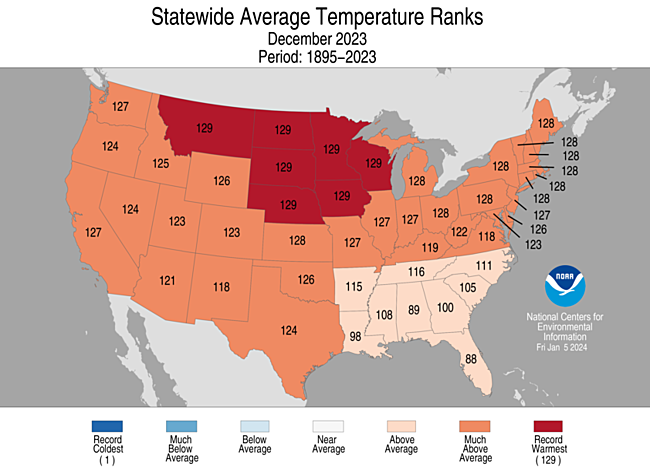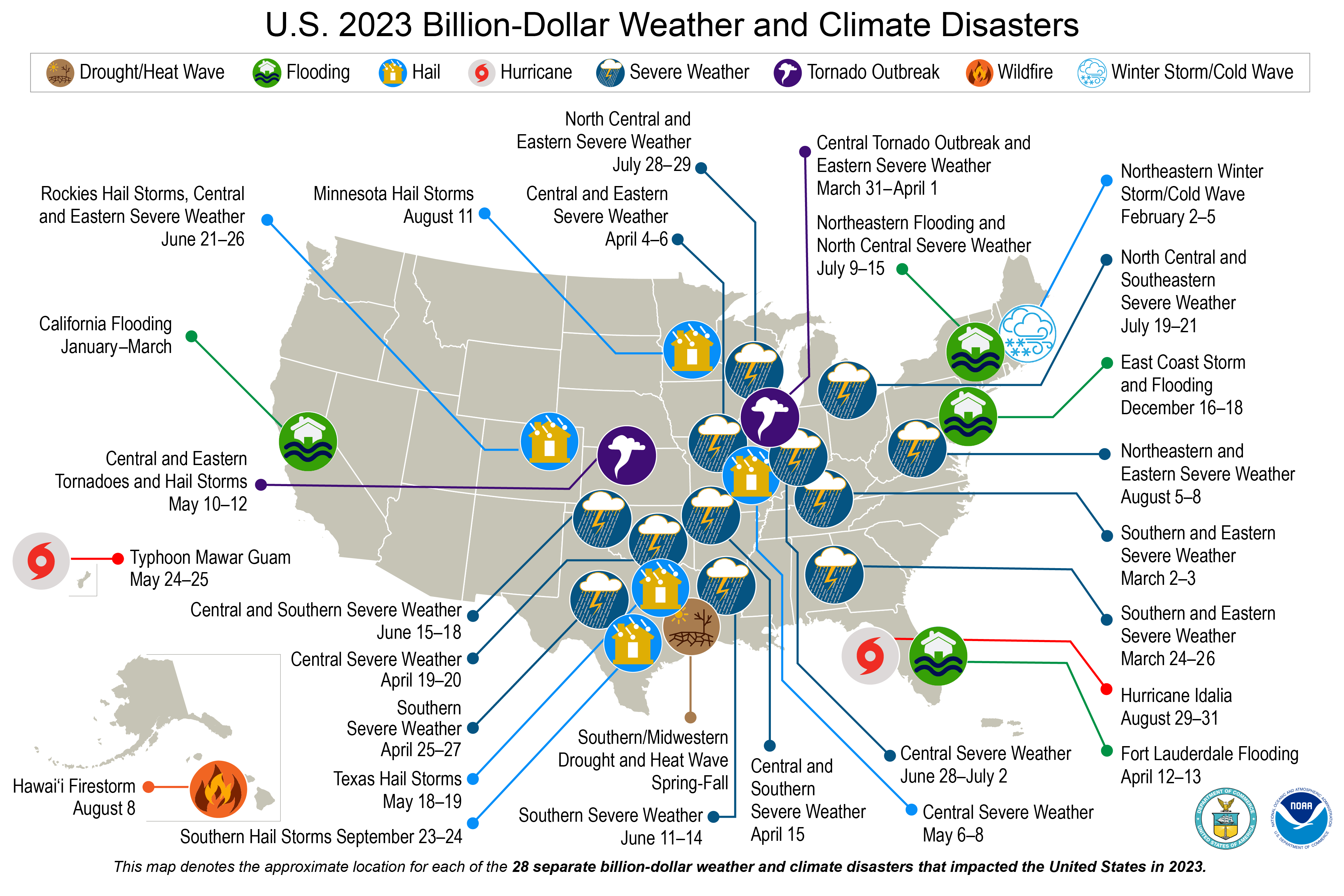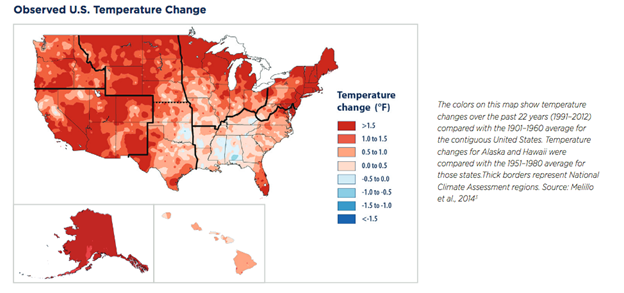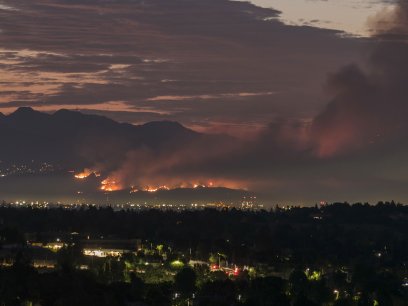
The National Ocean and Atmospheric Administration (NOAA) predicted warm, wetter-than-average weather across much of the United States during the 2023-2024 winter season. After three consecutive La Niña seasons, millions of Americans are now starting to feel the effects of El Niño conditions, such as an extended Pacific jet stream and amplified storm track across the southern US.
But whether it's an El Niño or La Niña year, communities around the United States are also being impacted by climate change this winter.

Map of statewide average temperatures ranks from NOAA depicting the majority of states with above-average temperatures in December 2023.
December 2023 was the warmest December on record for the country, with temperatures 7.3 degrees Fahrenheit above average. While all seasons are experiencing climate change, winters are warming the fastest in 38 out of 49 states analyzed by Climate Central, an independent science news organization. February is the month that is experiencing the most extreme warming trend.
If you’re not a fan of shoveling snow, you might like the sound of warmer winters at first. However, climate change means more than not having to bundle up when you go outside. It also brings new and drastic swings in weather patterns, and with that, impacts on human health. Some of these threats may not be as obvious as others.
Here are five ways that warming winter temperatures due to climate change can affect the health of you and your family, and how to prepare.
Unhealthy Air Makes Asthma Worse
Air pollution is a major contributing factor to climate change. Unhealthy air also directly causes or aggravates respiratory diseases like asthma. Higher temperatures cause ground-level ozone to increase, and exposure to ozone heightens the rate and severity of asthma attacks, causing nasal and eye irritation, coughing, bronchitis, and respiratory infections.
Additionally, rising temperatures in combination with higher carbon dioxide levels can make allergy season arrive earlier and stay longer. Higher pollen concentrations and longer pollen seasons can increase allergy symptoms, leading to more days missed from school and work for those who struggle with asthma.
Limited Water Availability Leads to Increased Drought
Mountain snowpacks are critical natural reservoirs that provide drinking water, irrigation, and hydroelectric power for millions of people around the world. When snow disappears earlier, it means less water is available for individuals, ecosystems, and agricultural use.
Droughts, which are expected to become more common in the United States, can destroy crops and grazing land, reduce the quantity and quality of water resources, and increase the risk of fire. Warmer weather conditions are already extending the average length of the growing seasons across the US.
Unseasonably Warm Winters May Lead to Extreme Heat Waves During Summer
Extreme heat events are already occurring in the US and are expected to become more common. Heat is the leading weather-related killer nationwide. The average number of extremely hot days in the United States is projected to more than triple between 2050 and 2100.
Earlier snowmelt leads to earlier vegetation growth, which lowers soil moisture and increases the likelihood of extreme and frequent heat waves during the summer. Heat waves and dry conditions can in turn lead to wildfires that result in carbon emissions and unhealthy air.
Warmer Temperatures Bring a Heightened Risk of Disease Outbreaks
Warmer weather means that insects that transmit diseases can show up earlier, and in new geographic areas. The most common insect-borne diseases are distributed by fleas, ticks, and mosquitoes. These diseases include Lyme disease, Dengue fever, West Nile virus, and Rocky Mountain spotted fever.
Additionally, increased temperatures and rainfall can contribute to increased outbreaks of infectious diseases like cholera, diarrhea, salmonella, and campylobacteriosis. Between 2030 and 2050, climate change is expected to cause 250,000 additional deaths per year due to heat stress, malaria, malnutrition, and diarrhea.
Extreme Weather Events Can Harm Physical and Mental Health
Strong tropical storms, as experienced during 2020’s record-breaking hurricane season, are also likely to become more common with climate change. In addition to the immediate physical danger presented by these weather events, the trauma of living through one can lead to post-traumatic stress disorder, depression, and anxiety.
In 2023, there were 28 weather disasters in the US that cost more than $3 billion each in damages, including droughts, floods, severe storms, and tropical cyclones. Overall, these events led to the deaths of 492 people and resulted in significant negative economic effects to local communities.

Here’s What You Can Do
Climate change is not experienced by everyone in the same way. Children, pregnant women, the economically disadvantaged, and the socially isolated are particularly vulnerable to its negative effects. However, we should all take steps now to adapt to our changing climate reality.
- Read NEEF’s climate change and health fact sheet to understand its direct and indirect effects.
- If you have experience asthma, know your triggers and eliminate exposure. learn how to stay safe. Check the Air Quality Index (AQI) often to understand environmental triggers in the air near you. If the AQI is high, limit your outdoor activities. You can prepare for allergy season by starting your medications a little early before symptoms kick in.
- Medical and public health professionals should review NEEF’s Pediatric Asthma Initiative for more information about asthma care and management, including a free eLearning course developed to help pediatric healthcare providers and clinicians manage environmental asthma triggers and intervention strategies.
- Follow the EPA’s tips for using insect repellents safely and effectively. Always read and follow label directions when using any pesticide product.
- Get prepared before an extreme heat event happens. Each spring, check your household’s fans and air conditioner to make sure they are in good working order. You can research local cooling centers and consider installing a green roof or cool roof to keep your home cooler. Read more about preparing for extreme heat from the CDC.
- Don’t overlook your emotional health. During and after a disaster, it is natural to experience different and strong emotions. Take care of yourself and your family’s mental health, and know when and how to seek help.



